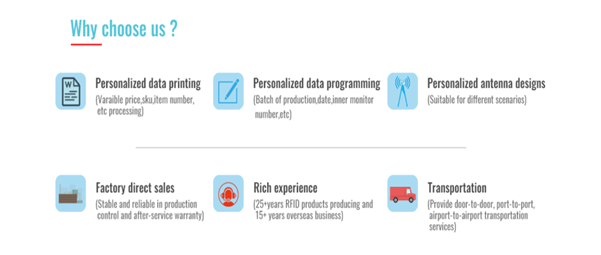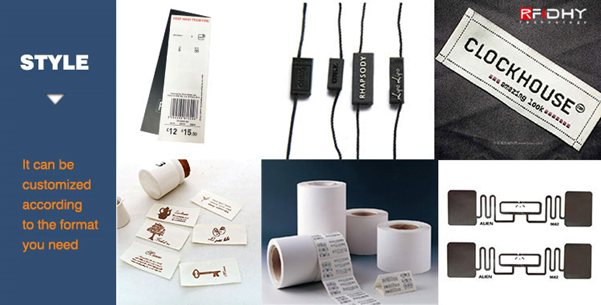De lijn- en kledingindustrie waren de eersten die RFID-technologie toepasten om de doorlooptijd tussen productie en detailhandel te verkorten.
Radio Frequentie Identificatie (RFID) technologie heeft bewezen een redder te zijn voor de snel veranderende mode-industrie door hun activiteiten te stroomlijnen en de efficiëntie te verbeteren.
Hoe werken RFID-kledinglabels??
Radio Frequentie Identificatie (RFID) technologie maakt gebruik van radiogolven om gegevens digitaal vast te leggen met minimale handmatige tussenkomst. RFID-tagging-systeem is vergelijkbaar met barcodering met extra voordelen.
RFID-technologie maakt gebruik van radiogolven om automatisch objecten te identificeren, gegevens over hen verzamelen, en voer die gegevens rechtstreeks in computersystemen in met weinig of geen menselijke tussenkomst. Een typische RFID-machine heeft drie componenten: RFID-tag, RFID-lezer en de antenne. RFID-tags bevatten een uniek nummer en andere details die door de lezer worden vastgelegd en omgezet in gegevens die op computers worden opgeslagen.
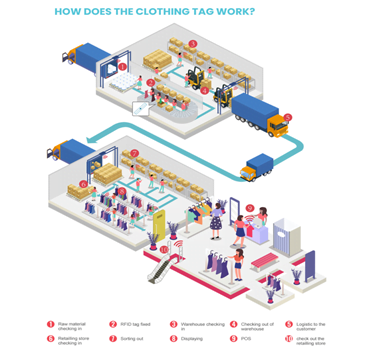
Wat is het gebruik van RFID-tags in de kledingindustrie??
RFID biedt betere controle en zichtbaarheid bij elke stap van de supply chain. Bedrijven kunnen de productie strikt controleren, verkoop en opslag door de hele keten op verschillende locaties zonder minimale personele middelen. Kledingindustrieën houden grote voorraden aan die moeilijk handmatig te beheren zijn. RFID-technologie stelt deze bedrijven in staat hun efficiëntie te verbeteren, verminder tijdverbruik en minimaliseer menselijke fouten.
Verbetert de kwaliteit: De kledingindustrie heeft veel te lijden van productschade en namaakproducten. Het is niet eenvoudig om elk beschadigd product handmatig te identificeren. RFID-tagging helpt bij het volgen van de goederen van productie tot opslag en maakt scannen op eventuele schade bij elk controlepunt mogelijk.
Beter voorraadbeheer: RFID-tagging helpt de verkoper bij het lokaliseren van hun lijnvoorraad. Ze kunnen snel achterhalen waar een lijn is opgeslagen en ook proactief een bepaalde stijl aanvullen voordat deze volledig is uitverkocht. RFID-tagging helpt bij het volgen van welke stijl snel verandert en naar welke ontwerpen meer vraag is. In het snel veranderende supply chain-scenario, RFID-tagging doet het werk in enkele seconden en houdt de fabrikant en verkoper op tijd klaar met hun voorraad.
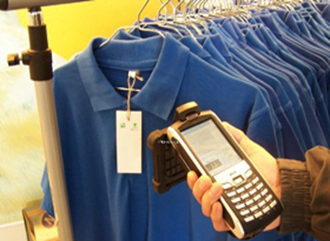
Meer controle en zichtbaarheid: RFID-tagging biedt betere controle en zichtbaarheid dan streepjescodes, omdat de voorraad automatisch wordt gevolgd en gecontroleerd bij elke stap van de toeleveringsketen. Bedrijven kunnen gemakkelijk ontbrekende producten achterhalen en schade volgen.
Langdurig: Met de traditionele tags en barcodes kan geknoeid en beschadigd raken door slijtage. Maar, RFID-tags zijn zeer duurzaam en gaan lang mee. Ze raken niet beschadigd in een ruwe omgeving, warmte, vuil en modder.
Breed scala aan tracking: Traditionele tags en barcodes vereisen een lezer om elke barcode handmatig te lezen. Terwijl, RFID-lezer kan meerdere tags scannen, zelfs vanaf een afstand van 100 voeten. RFID vereist geen sitelijn. Dit maakt het proces snel en betrouwbaar.
Dataveiligheid: De RFID-tags hebben een speciale chip met een uniek nummer dat niet kan worden gekopieerd. Traditionele systemen en barcodes zijn kwetsbaar voor datalekken en opnamefouten. Iedereen kan gemakkelijk een streepjescode dupliceren. RFID-tags bieden geavanceerde gegevenscodering die hackers niet kunnen kopiëren. Het verkleint ook de kans op gemiste items wanneer het wordt gebruikt om gegevens over grote aantallen items tegelijk te verzamelen, waardoor de kans op een menselijke fout wordt geminimaliseerd.
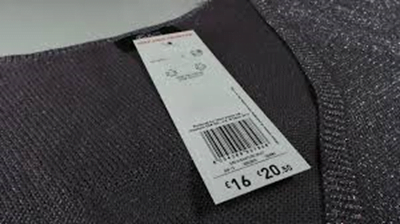
Anti diefstal: De RFID-lezer heeft een relaisuitgangsfunctie. Wanneer de lezer een specifieke tag leest, het sluit het relais waardoor het externe relais wordt geactiveerd om de alarmindicator te sluiten en te activeren;.
Lage bedrijfskosten: RFID-taggingsysteem is minder duur en tijdrovend dan het traditionele systeem. Het traditionele systeem brengt enorme arbeidskosten met zich mee. Ook, de traditionele tags moeten vanwege slijtage regelmatig worden vervangen. RFID-tags gaan lang mee, vandaar dat de vervangingskosten verminderen. De schaalvoordelen drukken de bedrijfskosten, net als bij het RFID-systeem, een enorme voorraad goederen en activa kan worden gescand met beperkte personele middelen en logistiek.
Korter proces: Met streepjescode, de lezer moet elk object één voor één scannen, wat het proces tijdrovend maakt. Maar, met RFID, duizenden tags kunnen in seconden worden gescand, waardoor de operationele tijd aanzienlijk wordt verminderd. Ook, RFID-technologie kan worden geïntegreerd met andere productie- en supply chain-technologieën en de doorlooptijd tussen bestelling en levering kan aanzienlijk worden verkort.
Lees/schrijfcapaciteit: Een streepjescode is alleen leesbaar en eenmaal afgedrukt, de gegevens op het barcodelabel kunnen niet worden gewijzigd. Maar, RFID-tags kunnen op elk moment worden gelezen en gewijzigd.
RFID-tags slaan meer gegevens op: In vergelijking met traditionele tags en barcodes. RFID-tags kunnen meer gegevens opslaan in het niet-vluchtige geheugen.
RFID kan worden toegepast met barcode: Als u streepjescodes gebruikt en wilt overstappen op RFID, of beide tegelijk wilt gebruiken. U kunt eenvoudig bedrukbare papieren labels aan RFID-tags bevestigen.
RFIDHY combineert innovatieve RFID-technologieën met tientallen jaren uitgebreide expertise in kledinglabels en labels om de beste in zijn klasse te bieden, op maat gemaakte zakelijke oplossingen voor onze klanten. Elke RFID-kledinglabel en elk label bevat elektronisch opgeslagen informatie, inclusief het producttype, grootte, kleur en diverse andere identificatie- en volgfuncties.
Al onze RFID-kledinglabels bieden snellere en efficiëntere productauthenticatie, het risico van verloren of vervalste producten verminderen, en volledig inzicht in de wereldwijde toeleveringsketen in realtime.
